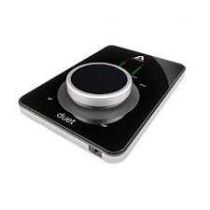
3 Verified Hands-On Reviews
To combat fake reviews we only accept video reviews from verified channels. Each review must show the product and the face of the reviewer.
Expert reviews [3]
- with a score: 0
- without a score: 3




Expert consensus
The Apogee Duet 3 audio interface is a versatile and high-quality solution for capturing and monitoring audio, offering a comprehensive set of input and output options, low-latency performance, and onboard hardware DSP processing.
The Apogee Duet 3 audio interface is a versatile and high-quality solution for capturing and monitoring audio. It offers a comprehensive set of input and output options, including mic/line inputs, instrument inputs, and balanced outputs, making it suitable for musicians, producers, and audio professionals.
The interface provides up to 65dB of gain with world-class microphone preamps, +48V phantom power for condenser microphones, and low-latency monitoring for real-time recording and playback. It also features a dedicated 0-ohm headphone output for optimal performance with any type of headphone. The Duet 3 is highly praised for its low-latency performance, allowing for zero-latency monitoring and real-time adjustments to sound.
Its high-quality preamps and exceptional sound reproduction capabilities make it suitable for recording demanding audio sources. The interface also includes onboard hardware DSP processing, specifically designed for Apogee's ECS Channel Strip plugin, allowing for zero-latency shaping of sound at the input stage.
The Duet 3 is compatible with both Mac and Windows operating systems, works with popular DAWs, and supports a wide range of third-party plugins. It has a positive brand reputation in the industry and has been utilized by renowned artists. Overall, the Apogee Duet 3 is a reliable and high-quality audio interface for professional recordings and monitoring.
Input/output options
The Apogee Duet 3 audio interface offers a comprehensive set of input and output options, including dedicated headphone output, making it a versatile and high-quality solution for recording and monitoring audio.
The Apogee Duet 3 audio interface offers a comprehensive set of input and output options to cater to different recording and monitoring needs. It features 2x Mic/line inputs, 2x Instrument inputs, and 2x Balanced outputs, allowing you to connect microphones, instruments, and other audio sources for recording or monitoring purposes.
The interface also has 2 USB Type-C ports for seamless data transfer and power delivery to your computer.
One standout feature of the Duet 3 is its dedicated 0-ohm headphone output, which ensures optimal performance with any type of headphone, regardless of impedance. This allows for high-quality monitoring during recording or mixing sessions.
The inputs and outputs are available through the breakout cable, which includes XLR inputs for microphones or line-level sources, instrument inputs for guitars or basses, and balanced outputs for studio monitors or headphones. The interface also provides a total of four input cables, allowing you to leave microphones or instruments plugged in while recording.
In terms of specifications and capabilities, the Duet 3 offers up to 65dB of gain with its world-class microphone preamps, +48V phantom power for condenser microphones, and low-latency monitoring for real-time recording and playback. It also has a compact and portable design, making it suitable for on-the-go recording, streaming, and podcasting.
Overall, the Apogee Duet 3 audio interface provides a versatile and high-quality solution for capturing and monitoring audio, making it a valuable tool for musicians, producers, and audio professionals.
What are the input and output options for the Apogee Duet 3 audio interface?
Based on 2 quotes from 2 sources [show quotes and sources]
What types of inputs and outputs are available on the Apogee Duet 3?
Based on 2 quotes from 2 sources [show quotes and sources]
What are the specifications and capabilities of the inputs and outputs on the Apogee Duet 3 audio interface?
Based on 3 quotes from 2 sources [show quotes and sources]
Can the Apogee Duet 3 be used for recording and playback simultaneously?
Based on 1 quotes from 1 sources [show quotes and sources]
Latency
The Apogee Duet 3 audio interface is highly praised for its low-latency performance, allowing for zero-latency monitoring and real-time adjustments to sound during recording.
The Apogee Duet 3 audio interface is highly praised by experts for its low-latency performance when it comes to recording and monitoring. The onboard hardware DSP allows for zero-latency monitoring, meaning there is no noticeable delay or latency when recording and listening to yourself in real-time.
This is particularly beneficial for musicians who need to stay in time with the music or monitor their tone and performance accurately.
The Duet 3's low latency also enables users to shape their sound right at the input stage with zero latency, thanks to the onboard hardware DSP. This means that effects, EQ, and compression can be applied to the audio signal while recording without any delay in the monitoring process.
Overall, the Apogee Duet 3 is designed to provide a smooth and responsive recording and monitoring experience, ensuring high precision and accuracy in capturing and monitoring audio. It is particularly well-suited for musicians and professionals who require real-time monitoring and need to make adjustments to their sound during the recording process.
What is the latency of the Apogee Duet 3 when recording and monitoring?
Based on 2 quotes from 1 sources [show quotes and sources]
What are the latency levels of the Apogee Duet 3 and how do they affect the recording and monitoring process?
Based on 3 quotes from 2 sources [show quotes and sources]
Preamp quality
The Apogee Duet 3 is a highly praised audio interface with exceptional preamps, offering precise and clear audio capture, as well as additional features like hardware DSP for zero-latency shaping of sound and the Apogee ECS plugin for enhanced recordings.
The Apogee Duet 3 is praised for its high-quality preamps and exceptional sound reproduction capabilities. While the specific frequency response range and noise levels of the preamps are not mentioned, the Duet 3 is known for its top-quality AD/DA conversion and pristine analog circuitry.
It features 2 world-class mic preamps with up to +65dB of gain, allowing for precise and clear audio capture, making it suitable for recording demanding audio sources.
The Duet 3 also provides +48V phantom power for condenser microphones, ensuring optimal performance with these types of mics. While specific details about distortion and harmonic distortion levels are not available, Apogee is generally recognized for its high-quality converters and preamps, suggesting that the Duet 3 delivers clean and transparent audio reproduction.
In addition to its preamp quality, the Duet 3 offers additional features that enhance the overall audio quality. It includes hardware DSP, allowing for zero-latency shaping of sound at the input stage. The onboard hardware DSP powers the Apogee ECS plugin, which provides a comprehensive set of tools, including EQ, compression, and saturation, to enhance recordings.
This feature adds flexibility and processing power to the preamps, giving users greater control over the quality and tone of their recordings.
Overall, the Apogee Duet 3 is a highly regarded audio interface with top-quality preamps, making it suitable for a wide range of recording needs, from capturing vocals and instruments to professional audio production.
What is the frequency response range of the preamps in the Apogee Duet 3?
How many preamps are included in the Apogee Duet 3, and what are their gain and noise levels?
Based on 2 quotes from 1 sources [show quotes and sources]
Does the Apogee Duet 3 provide phantom power for condenser microphones?
Based on 2 quotes from 1 sources [show quotes and sources]
What is the level of distortion and harmonic distortion in the preamps of the Apogee Duet 3?
Based on 2 quotes from 1 sources [show quotes and sources]
Does the Apogee Duet 3 have any additional features or technologies that affect the quality of the preamps, such as analog modeling or digital processing?
Based on 2 quotes from 1 sources [show quotes and sources]
DSP processing
The Apogee Duet 3 offers onboard hardware DSP processing for shaping sound at the input stage, providing professional-quality sound without the need for external plugins, although customization options are limited.
The Apogee Duet 3 is equipped with onboard hardware DSP processing, specifically designed for Apogee's ECS Channel Strip plugin. This allows users to shape their sound at the input stage with zero latency, providing professional-quality sound without the need for external plugins or additional processing hardware.
The DSP processing is highly regarded for its quality and efficiency in enhancing recordings. However, it's important to note that the DSP processing on the Duet 3 is limited to the included plugin and cannot be expanded or customized beyond this. The user interface for the DSP processing is generally user-friendly, but some reviewers have mentioned that adjusting the volume can be awkward and there is no volume indicator on the unit itself without relying on the software.
Overall, the Apogee Duet 3 is a reliable and efficient option for users who prioritize high-quality DSP processing and want a convenient solution for shaping their sound.
What types of DSP processing are available in the Apogee Duet 3?
Based on 2 quotes from 1 sources [show quotes and sources]
What is the quality of DSP processing in the Apogee Duet 3?
Based on 2 quotes from 2 sources [show quotes and sources]
Does the Apogee Duet 3 have any limitations or restrictions on DSP processing?
Based on 2 quotes from 1 sources [show quotes and sources]
How user-friendly is the DSP processing interface in the Apogee Duet 3?
Based on 3 quotes from 2 sources [show quotes and sources]
Does the Apogee Duet 3 have customizable or adjustable DSP processing?
Based on 2 quotes from 1 sources [show quotes and sources]
Compatibility
The Apogee Duet 3 audio interface is compatible with Mac and Windows operating systems, works with popular DAWs and iOS devices, and offers support for third-party plugins, but there have been reported compatibility issues on Windows.
The Apogee Duet 3 audio interface is compatible with both Mac and Windows operating systems. It can be used with popular Digital Audio Workstations (DAWs) such as Pro Tools, Logic Pro X, Ableton Live, Cubase, and Studio One. The interface also works with iOS devices like the iPhone and iPad.
It comes with Apogee's Maestro software, which provides an intuitive interface for controlling the audio interface and integrating it with your chosen DAW.
The Duet 3 is compatible with a wide range of industry-standard third-party plugins. It utilizes the Apogee FX Rack DSP plugin platform, allowing you to run professional-quality plugins directly on the interface's onboard hardware DSP. It comes bundled with the Symphony ECS Channel Strip plugin, and you can also use other Apogee plugins compatible with the FX Rack DSP platform.
Additionally, as a USB audio interface, you can use third-party plugins from other manufacturers depending on your DAW.
There have been some reported compatibility issues with the Duet 3 when used with certain software or plugins, particularly on Windows. While the interface is compatible with Windows, there have been complaints about its performance on that platform. It is recommended to research and check with software or plugin manufacturers for specific compatibility information before purchasing.
Setting up and configuring the Duet 3 is designed to be user-friendly. It is bus-powered and connects to your computer or iOS device using the included USB Type C / Type A cable. The interface features world-class preamps, 48V phantom power, and a hardware DSP for processing and monitoring audio with low latency while recording.
Overall, the Apogee Duet 3 offers compatibility with both Mac and Windows operating systems, a wide range of DAWs, and support for third-party plugins. However, it is important to research and consider user experiences, particularly on Windows, to ensure compatibility and performance for specific use cases.
What operating systems are compatible with the Apogee Duet 3 audio interface?
Based on 3 quotes from 2 sources [show quotes and sources]
What Digital Audio Workstations (DAWs) are compatible with the Apogee Duet 3?
Based on 4 quotes from 2 sources [show quotes and sources]
What third-party plugins are compatible with the Apogee Duet 3 interface?
Based on 2 quotes from 1 sources [show quotes and sources]
Are there any known compatibility issues with Apogee Duet 3 when used with certain software or plugins?
Based on 4 quotes from 2 sources [show quotes and sources]
How easy is it to set up and configure the Apogee Duet 3 with different software and operating systems?
Based on 3 quotes from 2 sources [show quotes and sources]
Brand reputation
The Apogee Duet 3 is highly regarded in the audio recording industry, with a positive brand reputation and endorsements from major artists.
The Apogee Duet 3 has a positive brand reputation in the audio recording industry. It is considered a professional-grade audio interface and has been used on releases by major labels. Artists like Nicki Minaj and Skylar Grey have used the Duet 3, further establishing its reputation as a capable and reliable audio interface.
The Duet series, including the Duet 3, has been praised for its quality and has been trusted by many musicians and producers for professional recordings. Overall, the Apogee Duet 3 is well-regarded among professionals and consumers in the audio recording industry.
What is the reputation of Apogee Duet 3 in the audio recording industry?
Based on 4 quotes from 1 sources [show quotes and sources]
How do customers perceive the customer support provided by Apogee Duet 3?
Based on 2 quotes from 1 sources [show quotes and sources]

Position in ranking
We maintain a monthly ranking that sums up expert recommendations for all audio recording interfaces.
| Rank | Change | Price | Audio Interface |
hollyland.com
|
bandpioneer.com
|
Wirecutter
|
Musician on a Mission
|
Sweetwater
|
Your Guitar Brain
|
EDM Sauce
|
Music Radar
|
soundref.com
|
producelikeapro.com
|
|---|---|---|---|---|---|---|---|---|---|---|---|---|---|
|
1
|
- | Check price |
 Focusrite Scarlett 2i2
Focusrite Scarlett 2i2
The Focusrite Scarlett 2i2 audio interface is a versatile and reliable device with low latency levels, upgraded preamp design, and a new Air mode that enhances high-end detail, making it a great choice for solo artists and mobile recording.
|
1
|
-
|
1
|
2
|
-
|
1
|
-
|
-
|
-
|
-
|
|
2
|
- | $200 |
 Focusrite Scarlett 2i2 4th Gen
Focusrite Scarlett 2i2 4th Gen
|
-
|
1
|
-
|
-
|
-
|
-
|
-
|
1
|
1
|
-
|
|
3
|
- | $100 |
 PreSonus AudioBox USB 96
PreSonus AudioBox USB 96
The PreSonus AudioBox USB 96 is a versatile and reliable audio interface with low latency, high-quality mic preamps, and compatibility with almost all recording software, making it an excellent choice for musicians, podcasters, and other audio professionals.
|
3
|
3
|
-
|
1
|
15
|
-
|
4
|
-
|
-
|
-
|
|
4
|
- | $199 |
 UA Volt 2
UA Volt 2
The UA Volt 2 audio interface is a versatile and high-quality device with low latency, two preamps based on the classic Universal Audio 610 tube preamp, and essential audio software, making it a reliable option for recording musicians, podcasters, and streamers.
|
-
|
2
|
3
|
-
|
-
|
-
|
-
|
-
|
-
|
3
|
|
5
|
- | $200 |
 Motu M2
Motu M2
|
-
|
5
|
-
|
-
|
-
|
7
|
-
|
-
|
4
|
-
|
|
6
|
- | $299 |
 Universal Audio Volt 276
Universal Audio Volt 276
The Universal Audio Volt 276 audio interface is a versatile and high-quality option for recording and playback needs, offering a range of input and output options, vintage and 76 compressor buttons, and a class-leading 24-bit/192 kHz audio conversion.
|
-
|
-
|
4
|
-
|
9
|
-
|
-
|
-
|
7
|
-
|
|
7
|
- | $349 |
 Solid State Logic SSL2+
Solid State Logic SSL2+
The Solid State Logic SSL2+ audio interface is a versatile and high-quality option for musicians, podcasters, and content creators, offering a range of input and output options, high-quality preamps, low-latency input monitoring, and powerful digital processing tools.
|
-
|
-
|
-
|
-
|
11
|
-
|
-
|
6
|
6
|
-
|
|
8
|
- | $649 |
 Apogee Duet 3
Apogee Duet 3
The Apogee Duet 3 audio interface is a versatile and high-quality solution for capturing and monitoring audio, offering a comprehensive set of input and output options, low-latency performance, and onboard hardware DSP processing.
|
-
|
-
|
-
|
-
|
17
|
3
|
-
|
-
|
-
|
10
|
|
9
|
- | $799 |
 Universal Audio Apollo Twin X
Universal Audio Apollo Twin X
The Universal Audio Apollo Twin X audio interface is highly praised for its versatile input/output options, low latency, top-notch preamp quality, powerful DSP processing capabilities, and compatibility with various software and operating systems, making it a recommended choice for home studios, project studios, and professional recording environments.
|
-
|
-
|
-
|
-
|
2
|
-
|
-
|
4
|
-
|
-
|
|
10
|
- | $109 |
 Behringer UMC204HD
Behringer UMC204HD
The Behringer UMC204HD audio interface is a versatile and reliable device that offers high-quality sound, low latency, and a range of input and output options, making it a practical choice for musicians, podcasters, and content creators.
|
5
|
-
|
-
|
-
|
-
|
-
|
-
|
-
|
3
|
-
|
|
14
|
- | Check price |
 Universal Audio Apollo Twin MKII
Universal Audio Apollo Twin MKII
The Universal Audio Apollo Twin MKII is a versatile and high-quality audio interface suitable for professional recording studios, home studios, and musicians who demand the best in preamp quality, offering a range of input and output options for recording and playback, extremely low latency levels, and powerful DSP processing capabilities.
|
2
|
-
|
-
|
8
|
-
|
-
|
-
|
-
|
-
|
-
|
|
15
|
- | $999 |
 RME Babyface Pro FS
RME Babyface Pro FS
|
-
|
-
|
-
|
-
|
13
|
-
|
-
|
-
|
2
|
-
|
|
16
|
- | Check price |
 Focusrite Scarlett 18i20
Focusrite Scarlett 18i20
The Focusrite Scarlett 18i20 audio interface is a versatile and high-quality product that offers 18 inputs and 20 outputs, low latency, transparent preamps, and a range of plugins for professional recording and production needs.
|
-
|
-
|
-
|
6
|
-
|
-
|
-
|
8
|
-
|
-
|
|
17
|
- | $2799 |
 Universal Audio Apollo x8p
Universal Audio Apollo x8p
|
-
|
-
|
-
|
-
|
8
|
-
|
-
|
-
|
-
|
8
|
|
18
|
- | Check price |
 IK Multimedia AXE I/O
IK Multimedia AXE I/O
|
-
|
-
|
-
|
-
|
18
|
-
|
-
|
5
|
-
|
-
|
| Show all rows | |||||||||||||








